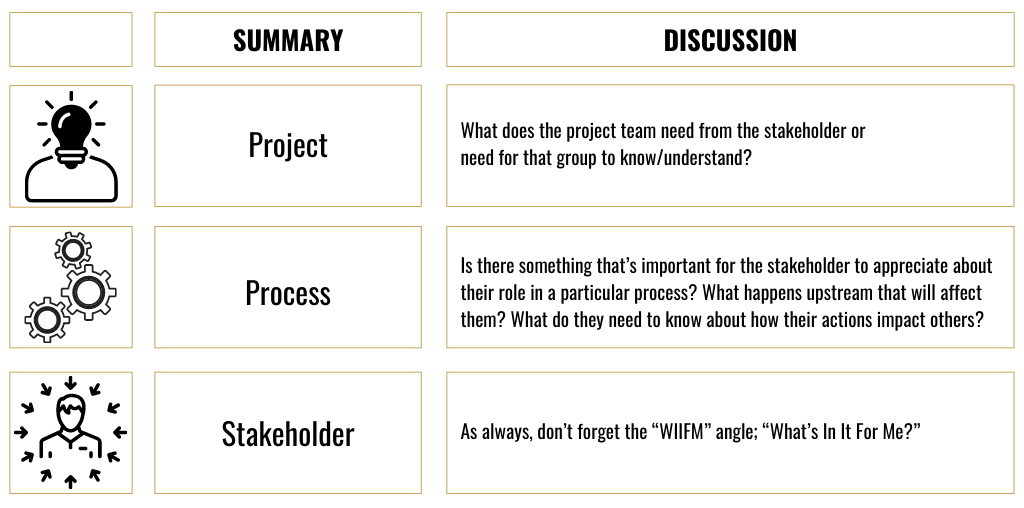6 Steps To Achieving Effective Communication Tactics During An ETRM System Implementation

There are myriad factors that contribute to the success or failure of energy trading and risk management (ETRM) system implementations. These run the gamut of reasons for project failure like the seven identified by Discenza and Forman in their paper for the PMI Global Conference, and many more unique to ETRM system implementations. While most are project management-focused or technical in nature, there’s a group of maladies rooted in poor communication at various stages of the project life cycle. Issues can manifest during the project implementation itself or crop up later after a new ETRM system is live.
For example, after go-live, the risk control group may observe significant and unanticipated swings in profit and loss (“P&L”) as month-end approaches. This phenomenon may simply be the result of schedulers waiting to update nominations until they know they’re needed by accounting to book accruals or generate invoices without realizing the impact this practice has on risk reporting.
How can these kinds of symptoms be mitigated? Can the root cause be addressed? The answer lies in effective tactical communication planning and execution as part of the organizational change management component of the implementation project. The good news for ETRM project sponsors and managers is that crisp communications is an affordable way to reduce implementation risk and drive adoption of the new solution.
Here are six effective communication strategies that can be applied to ensure undue risk is mitigated and the implementation process goes as smoothly as possible.
1. Identify Stakeholders
The first step in developing a tactical communication plan for your project is to compile a comprehensive list of project stakeholders. PMI defines project stakeholders as, “Individuals and organizations who are actively involved in the project, or whose interests may be positively or negatively affected as a result of project execution or successful project completion”. It’s important to note just how wide a net this definition casts.
Often, project managers tend to focus most on the people closest to the project as a natural result of the fact that the team needs information (e.g., requirements, testing, etc.) from those individuals in order to complete their deliverables. It can be especially effective to look deeper into the stakeholder population to identify key audiences to find individuals with secondary or tertiary impacts from the project. In many cases, it’s these groups and individuals that can surface late in a project implementation, or even after go-live, raising issues that can delay the project or erode the benefits case.
2. Determine Information Needs
Once all the stakeholders have been identified, it’s important to invest some time in determining and documenting their information needs. This isn’t a case for “one-size-fits-all” or “more communication is good communication”. In fact, taking either approach can create an unintended consequence or Cobra Effect, whereby an attempted solution to a problem could make the problem worse. The information needs of stakeholders are varied depending on factors such as their role in the project, the significance of the change they will experience with the system implementation and what phase of execution the project is in.
When developing messaging requirements, the communication analyst should consider multiple perspectives for each topic.

For example, at the time of project kick-off, an individual stakeholder in a group that’s expected to only be secondarily impacted by the ETRM system implementation may only need to be aware of the project and its high-level objectives to serve as an anchor point for future targeted communications. On the other hand, in the run-up to user acceptance testing (“UAT”) and power user for a group that’s highly involved in project delivery and operation of the system after go-live will likely have significant information requirements. They’ll need to know when UAT will be, what role they will play, what their system credentials are, how to log in and perform the testing, where to record results and how to report issues.
3. Select The Optimal Medium
One might assume that getting the right information to the right people would be sufficient and it certainly would go a long way in improving stakeholder engagement and buy-in. Gartner points out that communications should opt for the channel that best serves the particular audience and purpose and provides a useful matrix to aid in making the determination for certain kinds of messages. Most organizations have a number of existing channels for communication with employees such as town halls, newsletters, intranet sites, departmental email distribution lists and so on that can be utilized by the project as well.
An important consideration in selecting the optimal communication medium for a given topic is that individual recipients don’t consume and process information the same way. To ensure efficacy, it’s usually necessary to deliver the same content payload via more than one channel and with a varied mix of visual/written elements.
4. Establish A Cadence
For each item on the tactical communication plan a frequency and a delivery date will need to be identified. As previously mentioned, “once is usually not enough” so some thought should be given to how many times a stakeholder group or individual should be contacted on a particular topic. It’s recommended that timing of the delivery of messages should be a part of the overall integrated plan for the ETRM implementation since these communications generally serve particular phases of the project (e.g., kick-off, testing, training, cutover, etc.).
“Communication is inherently a two-way street and it’s crucial to take deliberate steps to understand how project messaging is being received and interpreted by the stakeholder community so that adjustments can be made along the way to make refinements.”
Once the first pass of the tactical communication plan has been roughed in it’s often valuable to group the activities by stakeholder community for review. Take a look at the number and timing of the planned messages and ensure that there’s a consistent cadence that’s appropriate for each group given the nature of their relationship to the project. Verify that the stakeholder group in question is receiving a relatively complete story arc over the course of the implementation life cycle.
5. Develop & Deliver The Messages
Developing and delivering the communications is where the rubber meets the road. There are a few excellent resources available online and otherwise to help understand how to write and/or present for groups effectively in a business context.
- “How to Improve Your Presentation Skills” – Inc.
- “How To Improve Your Business Writing” – Harvard Business Review
This particular aspect of project communication is very often an area where existing organizational capabilities can be well-leveraged to minimize cost and enhance effectiveness by:
- Working With Existing Communication Professionals in the Organization – Most companies have communication and marketing resources that can assist the project team with developing and delivering high-quality communications.
- Using Existing Communication Channels and Vehicles – There’s no reason to reinvent the wheel and most companies have regular town halls, newsletters, intranet sites, etc. to which stakeholders are accustomed.
- Considering the Sender – Who the message comes from DOES matter and it can be helpful to leverage familiar and trusted voices to increase the effectiveness of the communication.
6. Incorporate A Feedback Loop
Communication is inherently a two-way street and it’s crucial to take deliberate steps to understand how project messaging is being received and interpreted by the stakeholder community so that adjustments can be made along the way to make refinements. Even on projects that have well-established organizational change management tracks that are consistently delivering training and communications to the stakeholders, there’s rarely much opportunity afforded to gather feedback from those audiences with timing and tempo that enables the project team to adjust course for positive affect. Too often, the findings show up only as lessons learned at project close-out.
Some straightforward steps can be taken to increase the likelihood that feedback is sent, received and acted upon:
- Always include a “reply to” in any messages to stakeholders. This may be a project email inbox, a certain individual to contact via phone or the offer for follow-up conversations at the end of meetings.
- Consider using a simple survey instrument to periodically check awareness and understanding among larger stakeholder populations to identify and remediate gaps.
- Evaluate the potential for establishing small focus groups to represent highly impacted/integral stakeholder communities and engage in rich dialog.
- Actively monitor regular project status reports, status meetings, issue and risk logs for symptoms of insufficient or ineffective communication and follow up to diagnose and address them.
CONCLUSION
Many of the issues and challenges that plague major ETRM system implementation projects are borne out of the complexity of the systems themselves, stem from the high levels of integration required between systems or come from the significant specialized knowledge inherently required for energy trading and risk management. However, a number of these can be effectively addressed by a well-formed and well-executed tactical communication plan that’s right-sized for the scope and scale of the project. Consider engaging an ETRM expert, along with internal communications resources, early in the project planning phase to maximize positive elements of the change.
Related Insights
Looking for expertise in the energy industry? We’ve got you covered.
Find out why the new landmark legislation should provide a much-needed boost for the development of carbon capture.



